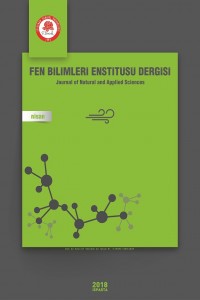Abstract
Dağıtık hizmet dışı bırakma eski bir siber saldırı yöntemi olmasına rağmen günümüzde saldırganlar tarafından hala kullanılmaktadır. Saldırganlar, internet üzerinde yer alan protokollerin mevcut zafiyetleri kullanılarak çeşitli katmanlarda bu tip saldırılar gerçekleştirmektedirler. Günümüzde makine öğrenmesi yöntemleri gelişen teknoloji ile beraber yüksek boyutlu veri kümelerine uygulanabilir olmaktadır. Siber saldırıların algılanması için kullanılacak olan veri kümeleri yüksek sayıda satırlar içeren log dosyalarıdır. Bu çalışmada dağıtık hizmet dışı bırakma saldırılarında elde edilmiş olan logların analiz edilerek tahmin modeli ortaya çıkarılması hedeflenmiştir. Topluluk yöntemleri kullanılarak, siber güvenlik veri kümeleri eğitilebilir duruma getirilmektedir. Farklı parametreler kullanılarak model performans ölçümü uygulanmıştır. Bu şekilde en yüksek doğruluğa sahip model oluşturulması hedeflenmiştir. Ortaya konulan modelin sınıflandırma performans ölçüsü tablo ve şekillerle paylaşılmıştır.
Keywords
Siber güvenlik Dağıtık hizmet dışı bırakma saldırıları; Makine öğrenmesi; Topluluk algoritmaları
References
- [1] Zargar,S. T., Joshi, J., Tipper, D. 2013. A Survey of Defense Mechanisms Against Distributed Denial of Service (DDoS) Flooding Attacks. IEEE Communications Surveys Tutorials, 15(4), 2046-2069.
- [2] Bhatia, S. 2016. Ensemble-based model for DDoS attack detection and flash event separation. Future Technologies Conference (FTC), 2016, 958-967
- [3] Kshirsagar, D., Sawant, S., Rathod, A., Wathor, S. 2016. CPU Load Analysis &; Minimization for TCP SYN Flood Detection. Procedia Computer Science, 85(2016), 626-633.
- [4] Katkar,V. D., Kulkarni, S. V. 2013. Experiments on detection of Denial of Service attacks using ensemble of classifiers. International Conference on Green Computing, Communication and Conservation of Energy (ICGCE), 2013, 837-842
- [5] Osanaiye, O., Cai, H., Choo, K.R., Dehghantanha, A., Xu, Z., Dlodlo, M. 2016. Ensemble-based multi-filter feature selection method for DDoS detection in cloud computing. EURASIP Journal on Wireless Communications and Networking 1(2016), 130-140.
- [6] Livadas, C., Walsh, R., Lapsley, D., Strayer, W. T.2006, Usilng Machine Learning Technliques to Identify Botnet Traffic. International Conference on Local Computer Networks, 1-16 Kasım,967-974.
- [7] Zhao, D., Traore, I., Sayed, B., Lu,W., Saad, S., Ghorbani, A., Garant, D. 2013. Botnet detection based on traffic behavior analysis and flow intervals. Computers & Security, 39(A), 2-16.
- [8] Saad, S., Traore, I., Ghorbani, A., Sayed B., Zhao, D., Lu, W., Felix, J., Hakimian, P. 2011, Detecting P2P botnets through network behavior analysis and machine learning. International Conference on Privacy, Security and Trust, 19-21 Temmuz, Montreal, 174-180.
- [9] Lu, W. , Rammidi, G., Ghorbani, A. A. 2011. Clustering botnet communication traffic based on n-gram feature selection. Computer Communications, 34(3), 502-514.
- [10] Masud, M. M., Al-khateeb, T., Khan, L. , Thuraisingham, B., Hamlen, K. W. 2008, Flow-based identification of botnet traffic by mining multiple log files. International Conference on Distributed Framework and Applications, 21-28 Ekim, Penang, 200-206.
- [11] Friedman, J. H. 2001. Greedy function approximation: a gradient boosting machine. Annals of statistics, 2001, 1189-1232.
- [12] Wang, H., He, X., Chang, M.-W., Song, Y., White, R. W., Chu, W. 2013, Personalized Ranking Model Adaptation for Web Search. International ACM SIGIR Conference on Research and Development, New York, 323-332.
- [13] Brillante, L., Gaiotti, F., Lovat, L., Vincenzi, S., Giacosa, S., Torchio, F., Segade, S. R., Rolle, L., Tomasi,D. 2015. Investigating the use of gradient boosting machine, random forest and their ensemble to predict skin flavonoid content from berry physical–mechanical characteristics in wine grapes. Computers and Electronics in Agriculture, 117, 186-193.
- [14] Moustafa, N., Slay, J., 2016. The evaluation of Network Anomaly Detection Systems: Statistical analysis of the UNSW-NB15 data set and the comparison with the KDD99 data set. Information Security Journal: A Global Perspective, 25, 1-3.
- [15] https://www.ixiacom.com/products/perfectstorm. 2017 PerfectStorm. (Erişim Tarihi: 01.06.2017)
- [16] qosient.com. 2017 Argus-3.0.8.2. (Erişim Tarihi: 01.06.2017)
- [17] tcpdump.org. 2015. tcpdump and libpcap latest release. (Erişim Tarihi: 15.04.2017).
Details
| Journal Section | Articles |
|---|---|
| Authors | |
| Publication Date | April 16, 2018 |
| Published in Issue | Year 2018 Volume: 22 Issue: 1 |
Cite
e-ISSN :1308-6529
Linking ISSN (ISSN-L): 1300-7688
All published articles in the journal can be accessed free of charge and are open access under the Creative Commons CC BY-NC (Attribution-NonCommercial) license. All authors and other journal users are deemed to have accepted this situation. Click here to access detailed information about the CC BY-NC license.

